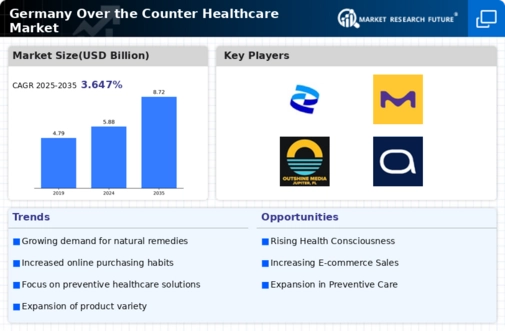The over-the-counter healthcare market in Germany is characterized by a dynamic competitive landscape, driven by innovation, consumer demand for self-care solutions, and an increasing focus on health and wellness. Major players such as Bayer (DE), Johnson & Johnson (US), and Procter & Gamble (US) are strategically positioned to leverage these trends. Bayer (DE) emphasizes its commitment to research and development, focusing on expanding its portfolio of consumer health products, while Johnson & Johnson (US) continues to enhance its digital health initiatives, aiming to improve consumer engagement through technology. Procter & Gamble (US) is also investing in sustainability, aligning its product offerings with eco-friendly practices, which resonates well with the growing consumer preference for sustainable products. Collectively, these strategies contribute to a competitive environment that is increasingly focused on innovation and consumer-centric solutions.
Key business tactics within the market include localizing manufacturing and optimizing supply chains to enhance efficiency and responsiveness to consumer needs. The competitive structure appears moderately fragmented, with several key players holding substantial market shares, yet numerous smaller companies also vying for attention. This fragmentation allows for diverse product offerings and fosters innovation, as companies strive to differentiate themselves in a crowded marketplace.
In October 2025, Bayer (DE) announced a strategic partnership with a leading digital health platform to enhance its consumer health product offerings. This collaboration aims to integrate digital health solutions into Bayer's existing product lines, potentially improving consumer access to health information and personalized care. Such a move underscores Bayer's commitment to innovation and its recognition of the growing importance of digital health in consumer decision-making.
In September 2025, Johnson & Johnson (US) launched a new line of over-the-counter pain relief products that incorporate advanced technology for faster relief. This product line is designed to meet the increasing consumer demand for effective and quick solutions to common health issues. The introduction of these products not only strengthens Johnson & Johnson's market position but also reflects a broader trend towards the integration of technology in healthcare solutions.
In August 2025, Procter & Gamble (US) unveiled its new sustainability initiative aimed at reducing plastic waste in its packaging. This initiative includes a commitment to using 100% recyclable or reusable packaging by 2030. By aligning its business practices with sustainability goals, Procter & Gamble (US) is likely to enhance its brand loyalty among environmentally conscious consumers, thereby positioning itself favorably in the competitive landscape.
As of November 2025, current trends in the over-the-counter healthcare market indicate a strong shift towards digitalization, sustainability, and the integration of artificial intelligence in product development and consumer engagement. Strategic alliances are increasingly shaping the competitive landscape, allowing companies to pool resources and expertise to innovate more effectively. Looking ahead, competitive differentiation is expected to evolve, with a notable shift from price-based competition to a focus on innovation, technology, and supply chain reliability. This evolution suggests that companies that prioritize these aspects will likely gain a competitive edge in the market.

















Leave a Comment